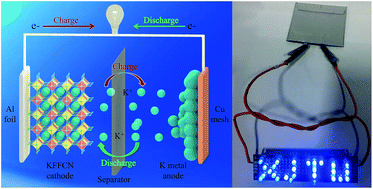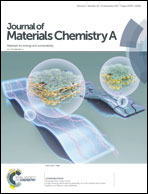Potassium ferrous ferricyanide nanoparticles as a high capacity and ultralong life cathode material for nonaqueous potassium-ion batteries†
Abstract
We propose potassium ferrous ferricyanide (KFeII[FeIII(CN)6]) nanoparticles with a 3D open framework structure as a cathode for nonaqueous K-ion batteries. Electrochemical reaction mechanism analyses identify that two redox-active sites based on C and N coordinated FeII/FeIII redox couples play a role in K-ion storage, and no phase change occurs in the different states of the initial and second charge–discharge processes. Thus, the KFeII[FeIII(CN)6] electrode exhibits a high discharge capacity of 118.7 mA h g−1 at an operating voltage of 3.34 V and extremely excellent cycling stability with a capacity value of 111.3 mA h g−1 after 100 cycles at 10 mA g−1. Moreover, an ultralong cycling lifespan of 1000 cycles with a high capacity retention of 80.49% and extraordinary voltage stability at 100 mA g−1 can be acquired. Ex situ characterizations verify that the outstanding electrochemical performance of KFeII[FeIII(CN)6] is attributed to superior structural stability and electrochemical reversibility upon long-term cycling. Therefore, the KFeII[FeIII(CN)6] material can make KIBs competitive in EES applications.



 Please wait while we load your content...
Please wait while we load your content...